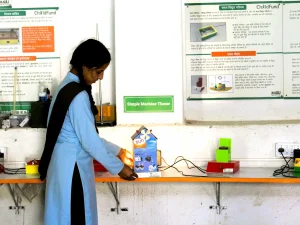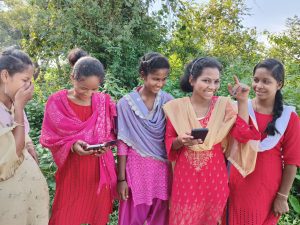Over 33% of India’s youth between 15-29 years of age aren’t in employment, education, or any training (NSSO 2021). Nearly one in three young Indians between the ages of 15 and 29 is not engaged in either education, employment, or training, and the numbers are even worse when it comes to women alone, according to the latest Multiple Indicator Survey report of the government’s National Sample Survey Office (NSSO).
Youth are not adequately equipped with the required skills to get into employment or promote their enterprises. The skills gaps are massive and do not match with market requirements. Lack of opportunities for vocational training at the local level coupled with the poor economic condition of parents forces the youth to engage in the informal sector. According to ILO, India will have a skill deficit of close to 29 million by 2030. As the country demands skills and workforce development, this blog post explores how ChildFund is empowering youth by building the capacity for employability skills through its e-Saksham centers.
ChildFund India Youth Program
ChildFund India has experience bringing changes in the community through the PACT EEE (Employment, Entrepreneurship, and Empowerment) program model initiative. It fosters youth development programs with a development aim to nurture youth who are skilled and involved. ChildFund India’s programs are based on the theory of change, and its program strategies are designed to support youth to achieve improved economic, physical, and social well-being and become change agents in their families and community. Recognizing that improving the quality of life of youth is critical in contributing towards poverty reduction. ChildFund India has been supporting underprivileged youth across its operational areas by providing employability and entrepreneurship training through its sustainable livelihood centers.
The PACT model focuses on engaging youth to acquire knowledge, skills, and experience that are necessary for them to engage in safe, sustainable, gainful, and non-exploitative employment or other livelihood activities. The program has demonstrated benefits to approximately a million individuals, centering on the concept of marginalized youth development through employability, entrepreneurship, and empowerment.
PACT EEE contributes to the Skill India Mission, the National Youth Policy (2021), and the National Policy on Skill Development & Entrepreneurship (2015). ChildFund India has established partnerships for the Training of Trainers with the International Labor Organization (ILO) and with the National Institute for Entrepreneurship and Small Business Development (NIESBUD). Furthermore, linkages are also provided to Jan Shikshan Sansthan and Pradhan Mantri Kaushal Vikas Yojana (PMKVY) which is the flagship scheme of the Ministry of Skill Development and Entrepreneurship (MSDE) implemented by the National Skill Development Corporation (NSDC). ChildFund India also focuses on common objectives of identifying, training, motivating, & facilitating unemployed youth to take up self-employment through RUDSETI (Rural Development and Self Employment Training Institute) and Rural Self Employment Training Institutes (RSETIs). The community self-help groups (SHGs) and ChildFund India field team have worked collectively to connect women entrepreneurs with the National Rural Livelihood Mission. ChildFund India has also been collaborating with NABARD to support the SHGs in establishing institutional linkages and has established collaborations with various Nehru Yuva Kendras for personality development of youth and Krishi Vigyan Kendras, which are focused on improving the agricultural economy of their respective districts.
Youth “workforce readiness” is an essential target of ChildFund India. It places a strong emphasis on educating young people about their rights, labor laws, what they can pursue, existing mechanisms, where to stop and where to say no, the benefits they should receive while working, and how to decide logically whether a workplace is safe or not.
E-Saksham centers:
In E-Saksham, ChildFund India has created “Youth Resource Centers” across project locations, and these centers work with local training facilities to act as centers for training and skill development. These resource centers have all the tools needed for education and skill development, and they help young individuals find jobs through networking, training, exposure trips, job placement aid, and career counseling. It also establishes linkages with technical and vocational education and training centers to persuade different demand-driven skill development programs.
In the E-Saksham Program, ChildFund India built resource centers in their project vicinity. These resource centers have been highly utilized and appreciated by the youth group as they contributed to building an entrepreneurial mindset amongst them. This program strives to develop the youth’s skills and capabilities to ensure meaningful employment. Youths are also focusing on digital advancements in learning skill development and education by accessing Skill India Digital Hub, which is transforming lives and building the futures of youth in India. It helps youth become more resilient to manage under trying circumstances as well as contribute significantly to their family’s overall income.
By 2030, India needs to create 115 million jobs to support its growing workforce, as one in five working-age people worldwide will be Indian (NSDC 2024). To achieve this, India must focus on several key areas by transforming the skill development ecosystem. ChildFund India will continue to support adolescents and youth to contribute to the sustainable development goal number 8 for decent work and economic growth with a comprehensive skill set composed of future skills, socio-emotional skills, demand-driven specialized skills, green skills, and digital skills.
Authored by Manjunatha H.T, Sr. Specialist (Livelihood), ChildFund India





